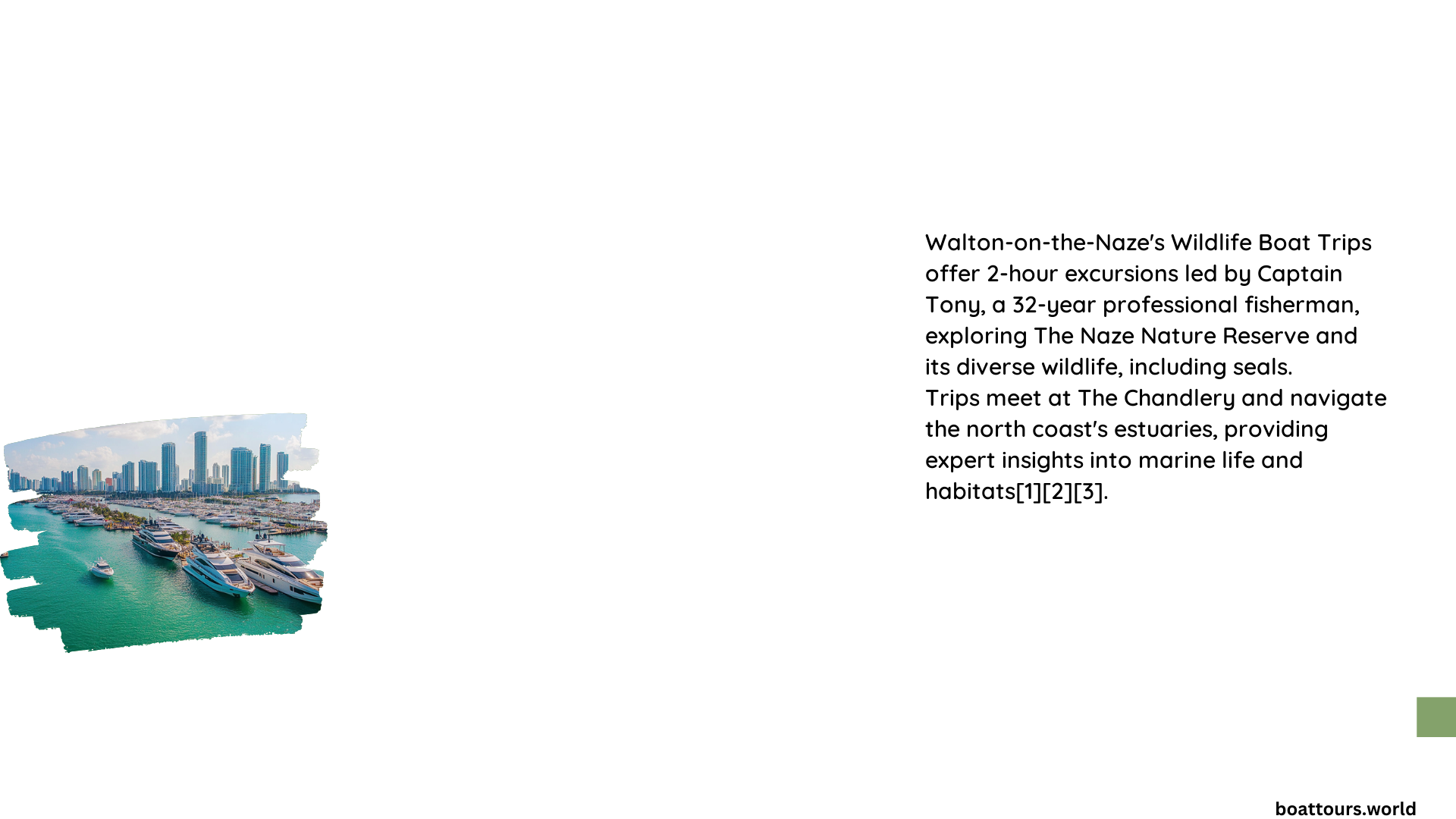Wildlife boat trips in Walton on the Naze offer an exciting opportunity to observe diverse marine life and birds in their natural habitat. These excursions, typically lasting 2 hours, depart from The Chandlery or Harwich Half Penny Pier. Visitors can expect to see seals, various bird species like Wigeon, Pintail, and Arctic Skuas. The trips accommodate up to 45 passengers in summer and 12 in winter, providing a unique eco-friendly adventure along the Essex coast.
What Types of Wildlife Can You Observe on These Trips?
Walton on the Naze boat trips offer a rich variety of wildlife sightings:
- Seals
- Seabirds:
- Wigeon
- Pintail
- Ringed Plover
- Curlew
- Dunlin
- Sandpipers
- Gannets
- Arctic Skuas
The diverse ecosystem of the Walton Backwaters provides an ideal habitat for these species, making each trip a unique wildlife experience.
How Long Do the Wildlife Boat Trips Last?

The standard duration for wildlife boat trips in Walton on the Naze is 2 hours. This timeframe allows for:
- Adequate exploration of the area
- Multiple wildlife sightings
- Informative commentary from guides
- A comfortable experience for passengers
What is the Maximum Passenger Capacity for These Trips?
The passenger capacity varies depending on the season:
| Season | Months | Maximum Capacity |
|---|---|---|
| Summer | April to October | 1-45 passengers |
| Winter | November to March | 1-12 passengers |
This seasonal adjustment ensures optimal viewing experiences and minimizes disturbance to wildlife during different times of the year.
Where Do the Boat Trips Depart From?
Wildlife boat trips in Walton on the Naze have two primary departure points:
- The Chandlery in Walton-on-the-Naze
- Harwich Half Penny Pier (for some specific tours)
Passengers should confirm the exact departure location when booking their trip.
Are There Onboard Restrooms Available?
While specific information about onboard restrooms is not provided, passengers are advised to:
- Bring hand sanitizer
- Carry tissues
- Prepare for a trip without restroom facilities
This suggests that onboard restrooms may not be available, and passengers should plan accordingly.
What Are the Seating Arrangements Like?
The boats are designed for passenger comfort, featuring:
- Heated cabins for protection from the elements
- Adequate seating for the maximum capacity
- Arrangements that allow for wildlife viewing
However, specific details about seating configurations are not provided in the available information.
How Accessible Are These Boat Trips for People with Mobility Challenges?
Accessibility features and challenges include:
- 40 steps from street level to the pontoon
- 3 additional steps to board the boat
- Handrails throughout for support
While efforts are made to accommodate passengers, the number of steps involved may present difficulties for those with significant mobility issues.
What Are the Price Differences Between Peak and Off-Peak Seasons?
While exact prices are not specified, it’s noted that:
- Summer season (April to October) has different rates compared to winter
- Winter season (November to March) likely has adjusted pricing due to reduced capacity
Potential passengers should inquire about current rates when booking.
Are There Any Group Discounts Available?
The available information does not mention specific group discounts. However, interested groups should:
- Contact the tour operators directly
- Inquire about potential discounts for larger bookings
- Check for any seasonal promotions or special offers
Do You Need to Rent Any Equipment for the Trip?
There’s no mention of equipment rentals, but passengers are advised to bring:
- Binoculars for better wildlife viewing
- Snacks and water
- Appropriate clothing for weather conditions
This suggests that essential equipment is not provided or rented on-site.
How Do Weather Conditions Affect the Boat Trips?
Weather plays a significant role in the boat trip experience:
- Trips may be affected by various weather conditions
- Passengers should check the forecast before their trip
- Appropriate clothing is essential:
- Waterproof gear for rainy conditions
- Layers for temperature changes
- Suitable footwear for boat conditions
When Are the Best Times for Bird Sightings?
Optimal bird sighting times vary, but generally:
- Migration periods (autumn and spring) offer the most diverse sightings
- Early mornings provide active bird populations
- Late afternoons can offer unique viewing opportunities
Specific species may have different peak viewing times throughout the year.
What Safety Regulations Should Passengers Be Aware Of?
Key safety regulations and guidelines include:
- No pets allowed to avoid wildlife disturbance
- Follow tour leader instructions at all times
- Bring essential items:
- Hand sanitizer
- Face coverings (for certain situations)
- Water and snacks
- Adhere to boat safety protocols
- Respect wildlife viewing guidelines to minimize disturbance
By following these regulations, passengers ensure a safe and enjoyable experience for all while protecting the local wildlife.
